From time immemorial, Church Tradition has acknowledged Our Lady as the one who’s “Yes” to the divine plan opened a new window for divine radiance to enter human history. All Christians are supposed to be lights in the darkness (Mt 5:14), of course, but only one human being who ever lived had the privilege of actually giving birth to the Light of the world.
 Some think that Catholic devotion to Our Lady means taking away from what we owe to Jesus, but this idea is absolutely foreign to twenty centuries of Christian history. Some go so far as to claim that we worship her – an idea Mary herself would be the first to reject! In fact, the Church’s amazingly rich theology and imagery of Mary view her, not as the light, but as a sacred window through which divine light streams into the world.
Some think that Catholic devotion to Our Lady means taking away from what we owe to Jesus, but this idea is absolutely foreign to twenty centuries of Christian history. Some go so far as to claim that we worship her – an idea Mary herself would be the first to reject! In fact, the Church’s amazingly rich theology and imagery of Mary view her, not as the light, but as a sacred window through which divine light streams into the world.
St. John Chrysostom (d. 407 AD), for example, compared Our Lady to a clear crystal goblet filled with choice wine. When held up to the rays of the sun, the entire vessel lights up and radiates its light and beauty all around. In this metaphor, Mary is the crystal receptacle: Christ is the choice wine. But it is the wine that radiates the light.
What an exquisite image! The Fathers of the Church were absolute masters at such imagery, as I’ll show below.
Her Mystery is Bound to His
Now we come to the reason why the ancient Fathers of the Church were so enamored of Mary and her place in history. Her very motherhood gave them an ability to defend the truth about her Son. In other words, the mystery of Mary is always bound up with the mystery of Christ, as we would expect. To defend Him, they needed to talk about her.
 These kinds of disputes, though, are not abstract. They come down to a concrete issue or crisis that divides people. One such dispute was the situation of a dangerous heretic of the early Church whose name was Nestorius (386-451 AD). He was the Archbishop of Constantinople for three years, but unfortunately, he used his exalted position to proclaim a falsehood about Jesus that needed to be addressed.
These kinds of disputes, though, are not abstract. They come down to a concrete issue or crisis that divides people. One such dispute was the situation of a dangerous heretic of the early Church whose name was Nestorius (386-451 AD). He was the Archbishop of Constantinople for three years, but unfortunately, he used his exalted position to proclaim a falsehood about Jesus that needed to be addressed.
In short, Nestorius put such an emphasis on the divinity of Jesus that he came close to denying that the Second Person of the Trinity actually became incarnate in a flesh-and-blood human being. His way to “prove” that Christ’s two natures were separate was to proclaim that the Virgin Mary gave birth only to the human Jesus, not to the divine Son of God.
In his native Greek, Nestorius used precise theological terms. He said Mary was only the Christotókos (Christ-bearer) but not the Theotókos (God-bearer).
The Church’s Belief
But if this seems like a lot of theological hair-splitting, then you should consider the words we recite in the Nicene Creed at Mass every Sunday. We affirm that Christ is “God from God, Light from Light, true God from true God” who came down from heaven and “was incarnate of the Virgin Mary, and became man.” You can see that the Light image is as ancient as our creeds. (The precursor of Sacred Windows, no doubt.)
Our Creed teaches us that the Lord’s divine and human natures are perfectly and totally united in the one Person of Jesus Christ, both Son of the Father and son of Mary of Nazareth. This is what theologians call the hypostatic union.
That belief was already formally declared by the Council of Nicea nearly a hundred years before this incident, but apparently, Nestorius didn’t get the memo.
An Orthodox Preacher
The dispute took a strange turn in the year 428, when Nestorius made the mistake of inviting a famed preacher of his day, the highly articulate bishop, Proclus of Constantinople, to preach a homily in the cathedral. Poor Proclus called Our Lady the God-bearer in his homily and immediately found himself in hot water with Nestorius who rejected the term Theotókos!
However, no one could take issue with the magnificent imagery of this preacher. Read through this next paragraph as though you were a member of that congregation listening to the mellifluous voice of Proclus singing the praises of Our Lady in these amazing verses:
The reason we have gathered here today is the holy Theotókos Virgin Mary, immaculate treasure of virginity, spiritual paradise of the second Adam, workshop of the union of [Christ’s two] natures, marketplace of the saving exchange, bridal chamber in which the Word was wedded to the flesh, living bush that was not burned by the fire of the divine birth, the true light cloud that bore the One who, in his body, stands above the cherubim, fleece moistened by celestial dew, with which the Shepherd clothes his sheep. (L. Gambero, Mary and the Fathers of the Church, Ignatius, 1999, 235.)
This wonderful preaching style goes by the Greek name of panegyric and finds no adequate translation into English. It is a compound word (from pan and agora), which simply means a public speech before an assembly, but it came to mean a list of praises spoken by a preacher or orator in public – a bit like our litanies, but always by way of preaching. Proclus was only one of a myriad of preachers to speak in such beautiful terms about Our Lady in this beautiful oratory style of the ancient Eastern Churches.
Hard-headed Nestorius, however, was not impressed. He did not hesitate to issue a public “correction” of the poor unsuspecting preacher, and in doing so, he sparked one of the most significant crises of the early Church.
Cyril of Alexandria Gets Involved
When Nestorius contradicted an orthodox preacher, he ran afoul of the very smart and rather temperamental bishop from Alexandria, Egypt, named Cyril, later declared Saint Cyril (after all his enemies were dead and everyone forgot about his bad temper, that is).
In his Easter letter of 429, Cyril rather rudely and publicly rebuked Nestorius for his denial of the term Theotókos and then, after compiling a long dossier of all Nestorius’ heretical ideas, sent it to Pope Celestine in Rome asking for confirmation of the orthodox position.
Ruins of ancient basilica in Ephesus where the council took place in 431 AD
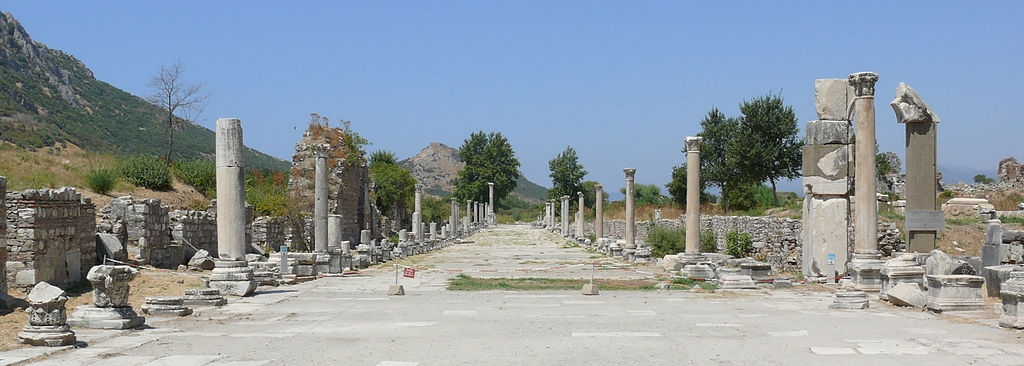
Clever Nestorius, however, also reached out to the pope (but remember, the pope had Cyril’s dossier by this time!). Then he upstaged Cyril by appealing for support from Emperor Theodosius II, who happened to be his friend and neighbor in Constantinople.
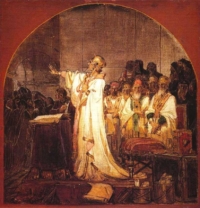 Bishops on both sides of the aisle got involved in the dispute, and the controversy soon reached a peak level of intensity. In time, the Emperor decided that enough was enough and called all bishops in the Roman Empire to meet in a neutral place to hash out their differences. (Theodsius is reputed to have blurted out, “WIll these meddlesome bishops ever stop bickering?” Okay, that’s not historical fact, but it’s probably not far from the truth.)
Bishops on both sides of the aisle got involved in the dispute, and the controversy soon reached a peak level of intensity. In time, the Emperor decided that enough was enough and called all bishops in the Roman Empire to meet in a neutral place to hash out their differences. (Theodsius is reputed to have blurted out, “WIll these meddlesome bishops ever stop bickering?” Okay, that’s not historical fact, but it’s probably not far from the truth.)
So, in the year 431, the bishops met in the city where one ancient tradition says the Virgin Mary lived out her final days. This was the famous Council of Ephesus. It was the third of seven major ecumenical (i.e., worldwide) councils held in the ancient Church.
Traditional site of the House of Mary in Ephesus called “Miryam-ana” in Turkish.
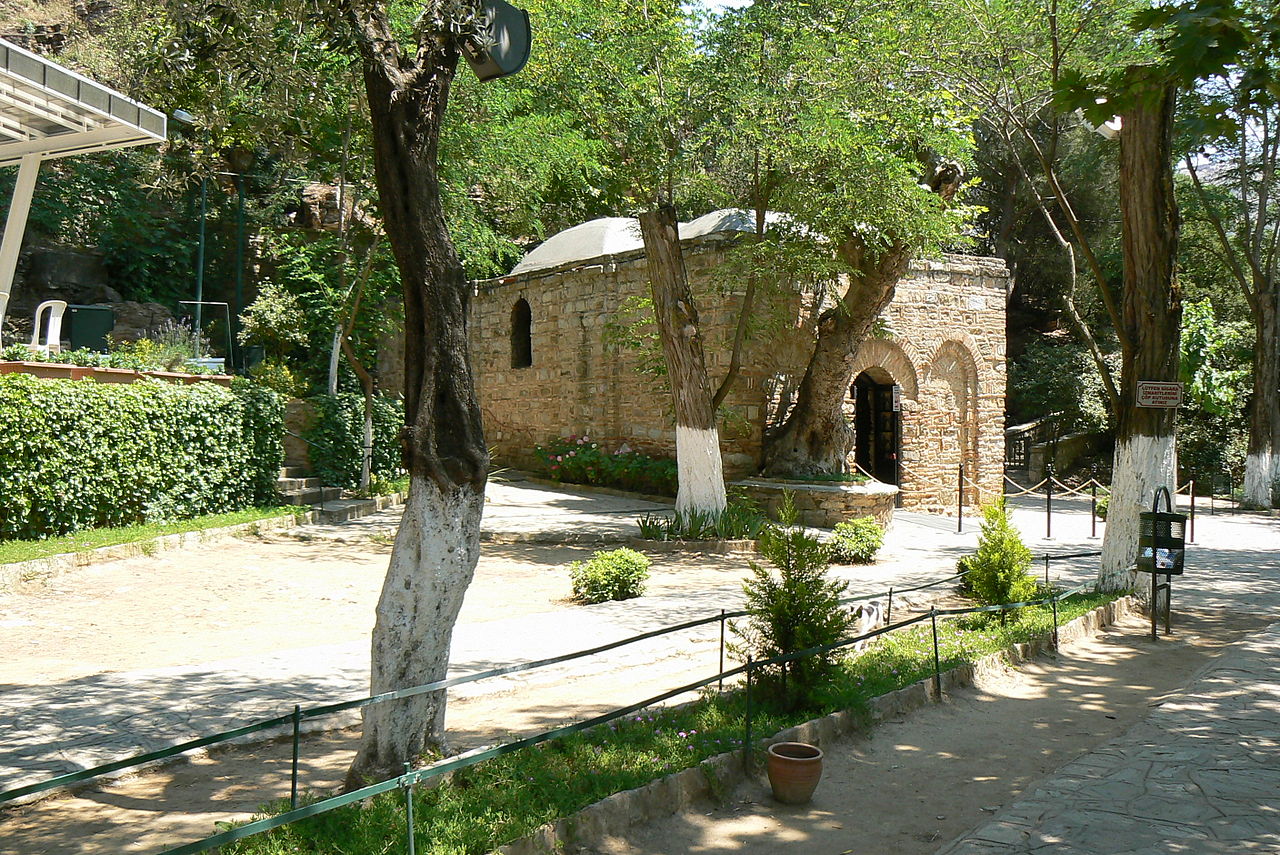
A Heretic Undone
In addition to being smart, intolerant, and temperamental, Cyril was also crafty. He and his allies arrived in Ephesus early. Then, before Nestorius’ delegation arrived from Constantinople, Cyril used his rank to convoke the Council and issue a condemnation of the heretical prelate, thereby illustrating the Lord’s admonition that “where two or three are gathered in my name, there will be politics.”
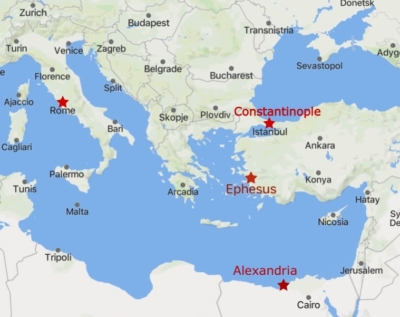 The papal delegation arrived several days later with documents from the pope backing Cyril’s position. In short, when Nestorius finally arrived, he never saw what hit him. He got a heavy dose of bad news all at once:
The papal delegation arrived several days later with documents from the pope backing Cyril’s position. In short, when Nestorius finally arrived, he never saw what hit him. He got a heavy dose of bad news all at once:
- His teaching was condemned by the Council;
- He was also excommunicated; and
- He was removed from his diocese and lofty position as patriarch of Constantinople.
It was not a good day or a good council for Nestorius. History simply remembers him as a heretic, but in fairness to the truth, he never repented of his heretical opinion either.
The story of the council is a complicated and colorful one. Soon after that, Nestorius and his team set up their own council and proceeded to excommunicate Cyril in turn!
The Emperor eventually had to weigh in and fix the mess. In doing so, he arrested the two headstrong bishops, and eventually sent them both away (Nestorius into exile and Cyril back to Egypt), and the council was thus concluded on a very sour note. I’ll spare you the rest of the details.
(Image: Ruins of the ancient basilica in Ephesus where the council took place.)
Yet, on the plus side, the declaration that Cyril and his cohort had published at the start of the council was never rescinded by council, pope, or Emperor and remains the orthodox teaching of the council. Cyril’s position prevailed, not because he was crafty, but because his orthodoxy was firmly backed by the pope as expressing the eternal truth about Christ. We know this because, 1600 years after the fact, we recite it every Sunday in the Creed to this very day.
Cyril’s Eloquence
To cap things off, it’s good to know that Cyril was not only a schemer. He eventually became a saint because of his orthodoxy and had his own significant abilities as an eloquent preacher. His impudence in calling Nestorius a heretic, a blasphemer, and a whole bunch of other names will not be remembered as much as his eloquent panegyric to Our Lady which will be our closing tribute to the Virgin Mary on this Mother’s Day:
We hail you, O Mary Mother of God, venerable treasure of the entire world, inextinguishable lamp, crown of virginity, scepter of orthodoxy, imperishable temple, container of him who cannot be contained, Mother and Virgin, through whom it is said in the holy gospels: “Blessed is he who comes in the name of the Lord” (Mt 21:9).
Hail, you who held the Uncontainable One in your holy and virginal womb! Through you, the Holy Trinity is glorified; the precious Cross is celebrated and adored throughout the world; heaven exults, the angels and archangels rejoice, the demons are put to flight, the devil, the tempter, falls from heaven, the fallen creation is brought back to paradise, all creatures trapped in idolatry come to know of the truth.
~St. Cyril of Alexandria, Homily IV Preached at Ephesus against Nestorius, PG 77, 992-96.
Amen!
———-
[Note: This article is a reproduction of the Sacred Windows Email Newsletter of 5/14/23, so it does not end with the regular Soul Work section. Please visit our Newsletter Archives.]
Photo Credits: (Cyril at the Council) Василий Суриков, public domain via Wikimedia Commons; Madonna, by Sassoferrato, public domain; (Basilica panorama) Ad Meskens, CC BY-SA 3.0 via Wikimedia Commons; (Miryam-ana) Rita1234, CC BY-SA 3.0 via Wikimedia Commons; (Wine glass) Manali Winery, Sikinos; Madonna and Child, public domain, by Botticelli.
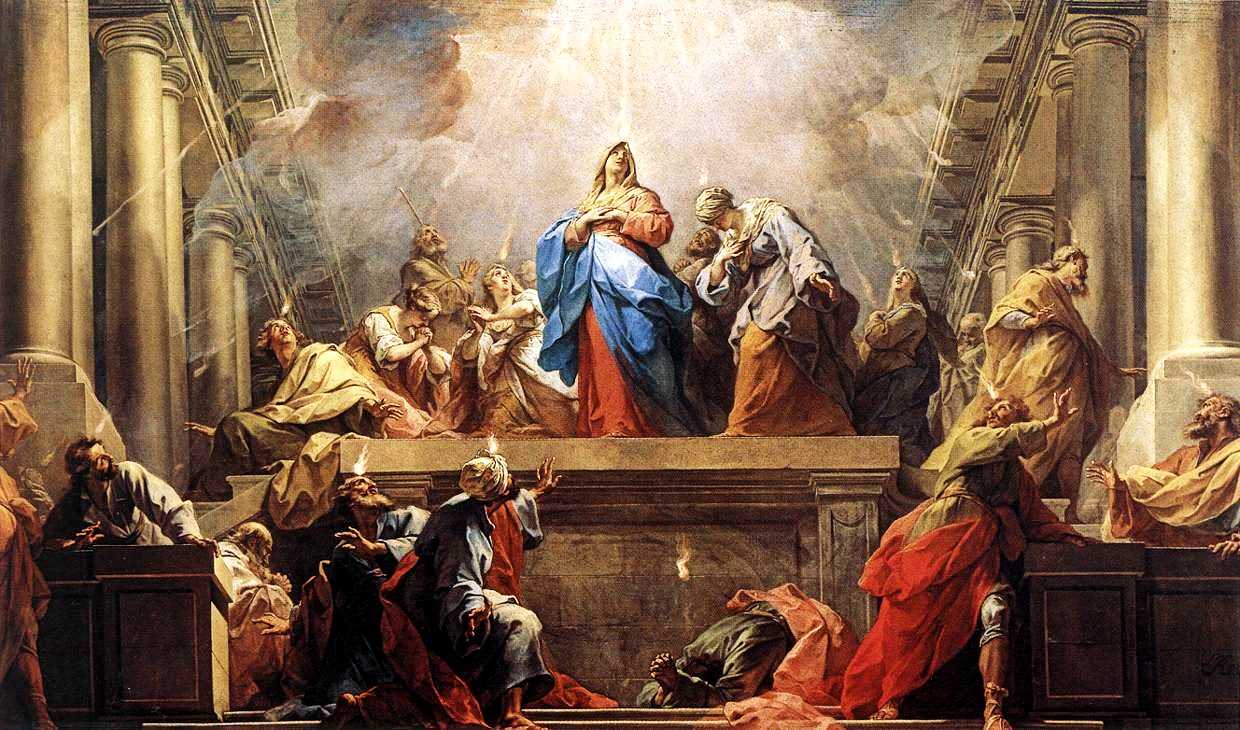
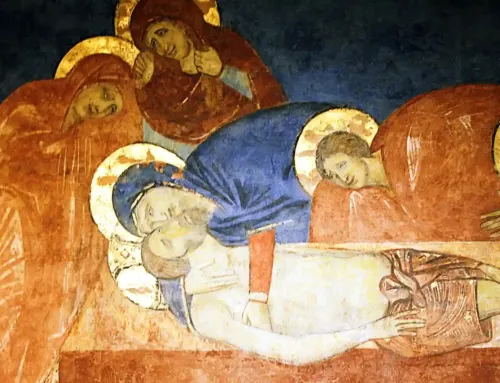
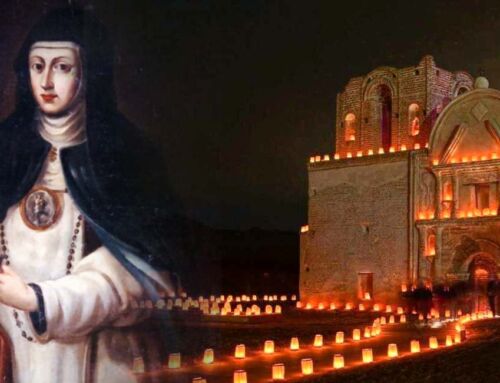

Leave A Comment